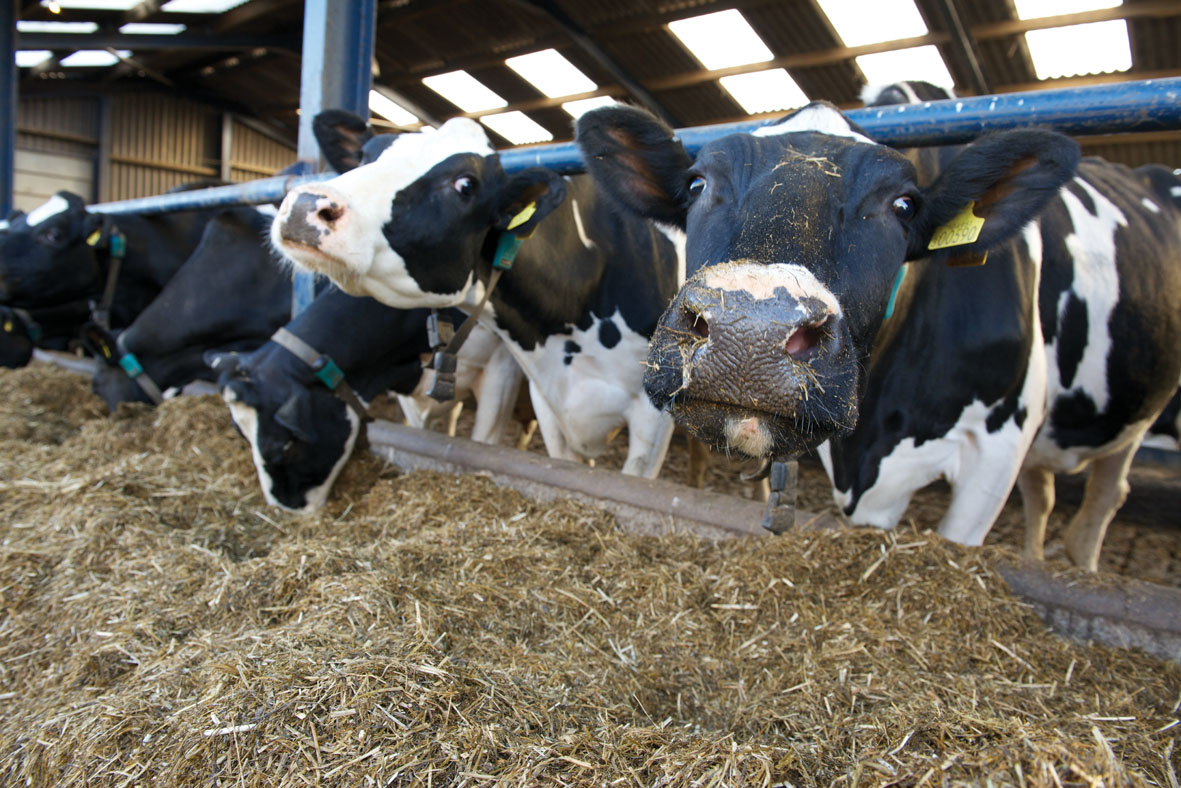Cow housing
Poor cubicle comfort has a significant impact on herd performance, as cows will spend less time lying down chewing the cud. There is a clear positive correlation between longer cow lying times and milk yields, as blood flow to the cow’s udder increases the longer she stays lying down.
Getting the length and width of cubicle beds right is therefore vital, and it will vary from breed to breed. Generally for a Holstein x Friesian, cubicles should be 2.43m long by 1.22m wide. If you are seeing cows standing and perching with their front legs on a cubicle bed it is a good indication of poor comfort.
Overstocking is another issue, with overstocked sheds leading to bullying and stress, resulting in lower feed intakes and reduced milk yields. It is usually new members of the milking herd that suffer the most, particularly heifers. Buildings should ideally be stocked at 85 cows per 100 cubicles and each cow should be provided with at least 65cm of space at the feed barrier. A simple rule of thumb is to have 2 rows of cubicle beds per bay of head feed space.
It is important that feed barriers are set at the right height for different breeds, as barriers that are too low will deter cows from spending time at the feed barrier.
Adequate lighting of at least 300 lux for 18 hours of the day has been shown to aid feeding rates and drive intakes, and good ventilation is also important to create a healthy housing environment. Shed design should ensure that fresh air is drawn in from the ventilated sides of the building and pushed up and out through an open ridge in the roof. This ensures that fresh air is constantly circulating through the building, reducing levels of condensation, increasing cow comfort and minimising the risk of pneumonia.
Keeping stressful activities to a minimum in the milking herd also contributes to optimal feed efficiency, as stress diverts energy away from milk production.
Monitor what your cows are telling you
Cows should be closely monitored to ensure that herd management is delivering the desired results, and creating an environment in which cows are producing the maximum amount of milk from feed intakes.
If you see cows lying down in their cubicles, chewing the cud, with strong, vigorous jaw movements for more than 10 hours per day then that is a good indication that diet and housing environment are correct. At any one point in time more than 60 per cent of the herd should be lying down ruminating in a cubicle bed, with all other cows eating or drinking water.
Monitoring dung consistency and composition will also help assess rumen performance. Undigested fibres and grains are indicative of inadequate rumen function, potential acidosis or poor cereal processing, all of which mean cows aren’t getting the most from their feed.
Rumen fill can also be assessed by viewing the triangular area behind the last rib on the left hand side of a cow. When viewed from behind this area should appear full, three to four hours after milking. Assume that if it is not, environmental factors or feed need to change to encourage better feed intakes.
Abrasions on a cow’s hocks and legs can indicate poor cubicle design and bald patches on the neck can signify a feed barrier that is too low and likely to be restricting feed intakes.
Actisaf live yeast
Feeding for marginal litres is unlikely to provide a return on investment this winter, with the milk price to feed ratio being too close.
However, supplementing feed with Actisaf yeast will provide a good return on investment, with peer reviewed research demonstrating that Actisaf consistently improves feed intakes, stabilises rumen pH and aids the prevention of acidosis - all of which will help improve feed efficiency.
Actisaf has been proven to deliver up to three litres of extra milk in early lactation cows, and even if it were to provide only one extra litre, supplementation would still provide a 3:1 return on investment, based on current milk prices.
The rumen of a modern cow contains oxygen that is highly toxic to rumen microbes, particularly those that digest fibre. Actisaf lowers the oxygen level in the rumen, allowing rumen microbes to grow and digest more fibre at a faster rate, aiding energy production.
Actisaf stimulates these microbes to work harder and faster. This is beneficial for high yielding cows with high feed intakes, as rumen microbes do not normally have the time required to digest large intakes of feed properly.
Live yeast also helps to neutralise rumen acidity and maintain a stable rumen pH, thereby preventing acidosis. This rumen stability also aids feed transition, particularly when cows are initially housed off grass or changing between clamps of forage and other dietary ingredients.
Feed efficiency is a complex subject that is influenced by a large range of interrelated factors. Feed composition and consistency, good cow management and careful observation are key management factors that will help to ensure that a herd maximises feed efficiency this winter. It is also worth feeding Actisaf live yeast to maximise fibre digestion from forages and promote a stable rumen environment, both of which are essential if optimal feed efficiency it to be attained.
To read the first part on this article on feed efficiency, please click here.

